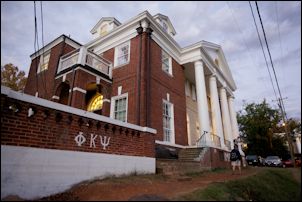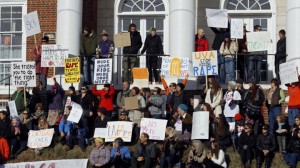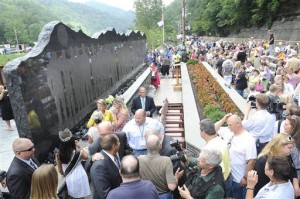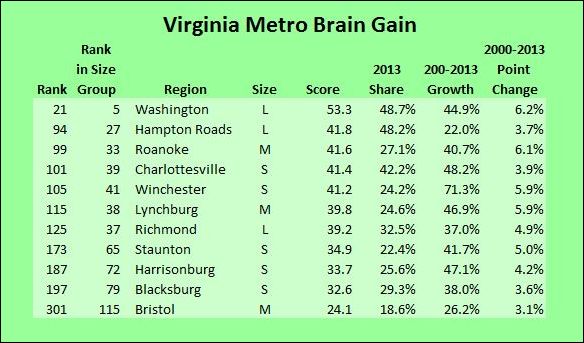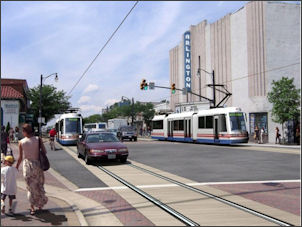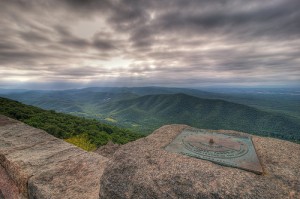
Watch it, buddy, make sure you read the University of Virginia’s “Definitions of Prohibited Contact” before you touch that woman!
by James A. Bacon
In the wake of gang rape allegations aired last week by Rolling Stone magazine, University of Virginia officials declare themselves to be angered by the incident and determined to prevent anything like it from happening again. “I write you in great sorrow, great rage, but most importantly, with great determination,” wrote President Kathleen Sullivan in a letter to the University of Virginia community. “Meaningful change is necessary. … This will require institutional change, cultural change, and legislative change, and it will not be easy. We are making those changes.”
If past is any precedent, we can look forward to a more verbose Student Sexual Misconduct Policy replete with legalese of the sort one might read in an Apple App user agreement, the hiring of more administrators to enforce the policy, the occasional drumming out of sexual offenders and… virtually no change to the “culture of rape” that led to the gang rape in the first place.
The reason that change will not occur is that the University of Virginia, like colleges and universities across the country, are caught between conflicting moral imperatives which Baby Boomer administrators are incapable of reconciling. On the one hand, Boomer administrators are appalled by sexual violence against women, which appears to have reached unprecedented proportions on their watch. On the other hand, they are unwilling to do anything to curb the licentiousness and promiscuity of the drunken hook-up culture that pervades the student culture and creates an ethical gray area regarding what constitutes a woman’s “consent” to sexual activity.
The only way that university bureaucrats know how to deal with this inherent conflict is to put into place stricter rules and procedures that students will ignore, just as they’ve ignored all the past rules and procedures. Even if the new regime of campus justice does succeed in bring more sexual transgressions into the maw of administrative review, students may well respond in unexpected ways. Already, male students are using videotapes to successfully refute charges of rape, according to the Women for Men blog. The net effect could well be to spur young more students to surreptitiously videotape themselves and their paramours in the act.
The problem is human nature. Young men and women, who are at the peak of their sex drive during their campus years, are obsessed with sex. This obsession is hard-wired into the species. Different civilizations and cultures over the eons have devised various mechanisms to channel and control the sex drive. In the United States the prudish “Victorian morality” prevailed for many years. That system stressed premarital abstinence and the strict policing of college campuses to limit the opportunities of couples to engage in sex. The system of Victorian morality was far from perfect, even on its own terms — it was, after all, fighting against human nature. Some women did get pregnant. Rapes did occur. As correspondent Gerald Cooper reminds me, in the so-called “Lawn Scandal,” three young men from prominent Virginia families were implicated in the gang bang of a young woman in a room on the Lawn around 1954. But there was no “campus culture of rape” in which 20% of all women were raped during their four years in college.
Victorian values were swamped by the sexual revolution and the rise of feminism. Few people who grew up in the 1960s or later regret the overthrow of the ancien regime. Most people, even many cultural conservatives, accept the proposition that single people should be free to express their sexuality. (Victorian morality still prevails when it comes to respecting the vows of matrimony; not everyone lives up to the moral norm but almost everyone accepts it.) On college campuses, the floodgates opened. When colleges ceased policing students’ sexual activities, students were free to pursue their primal instincts. Residential colleges like UVa threw together thousands of young people at the peak of sexual desire and looked the other way as a new culture arose that mixed heavy drinking with sexual license.
The Baby Boomers who dominate the ranks of college administrations today shocked their parents with their cavalier attitude toward sex before marriage. A few Boomers engaged in “swinging,” or the swapping of sexual partners, but that behavior was relegated to the fringe. The prevailing ethos among Boomers, even among singles, was to restrict sex to monogamous relationships. Boomers had more sexual partners than their parents did, but their morality still frowned on sexual promiscuity.
Now it is the Baby Boomers’ turn to be shocked by their children. Prevailing feminist theory on college campuses, reinforced by pop culture figures like Madonna, deemed it chic for women to be as sexually “empowered” as men, in effect to have sex with whomever they wanted whenever they wanted. For many men, this development was a dream come true — women offered sex without the encumbrances of emotional commitment. Whereas Boomer women bartered sexual access for emotional commitment, many (not all, of course) Millennial women demanded nothing in return. Young people in college today live in a state of moral anarchy, some retaining vestiges of traditional morality, while others abide by no discernible sexual morality of any kind. The only recognized standard is the admonition that women must “consent” to sex.
The great question is how to interpret consent. The overwhelming majority of “rapes” on college campuses occur in a party context in which men and women alike are intoxicated. Sometimes the lines are clear. When a man plies a woman with a date rape drug and has sex with her, everyone would agree that that’s a case of rape, even if there was no violence involved. Everyone would agree that the gang rape at the University of Virginia, if it occurred as described, was horrific. No one sympathizes with the rapists in either case.
But the lines become blurred in an instance, say, in which a women gets drunk, starts making out with a guy, who also happens to be drunk, has sex with him and at some point along the line changes her mind. Is that “rape?” If so, do we place that in the same category of moral and criminal culpability as a case in which, say, a man stalks a woman and rapes her at gunpoint? Feminists might argue that in an oppressive, patriarchal society such a distinction is meaningless. Most people see a big difference.
Further blurring the lines is the rise of the exhibitionist “sexting” culture. Baby Boomers find themselves prudishly aghast as they hear of Millennials emailing photos of their their genitals to love interests. Do the kids have no sense of privacy at all? Then there is the phenomenon of “revenge porn.” Men create videotapes of themselves having sex with girlfriends and then post the videos online to get back at them for some perceived offense. Those trends have made it into the news, but they are just the tip of the iceberg. Google “college sex party” and browse the results. You will find dozens, if not hundreds, of videos posted of college kids stripping, walking around nude, engaging in oral sex and copulating without embarrassment in front of their peers. This kind of behavior may be extreme and unrepresentative of the general student population but its very existence is indicative of how thoroughly the old sexual norms have been obliterated.
I offer as a hypothesis the proposition that the college rape epidemic is deeply rooted in the drunken hook-up culture of the Millennial generation. Liberal Boomer college administrators, who make a fetish of being non-judgmental, have allowed this culture to arise without contesting it. The consequence is that as a matter of routine every Friday and Saturday night, young men and women are thrown into situations where the lines between consensual and non-consensual sex are blurred beyond recognition. It should come as no surprise that the victims of sexual transgressions and their friends are so often morally ambivalent about whether to report incidents or not.
Given the tenor of what takes place in college frat houses, dormitories or the bushes behind the Rotunda, how likely is it that the University of Virginia’s “Definitions of Prohibited Conduct” will have any effect upon students’ behavior?
The party desiring to initiate sexual activity is responsible for obtaining Effective Consent. In order to obtain Effective Consent, permission must be given prior to or contemporaneously with the sexual activity in question. Effective Consent should never be assumed. Lack of protest or resistance does not constitute Effective Consent. “No” means no, but nothing (silence, passivity, inertia) also means no. A verbal “No,” even if it sounds indecisive or insincere, should always be treated as a denial of Effective Consent. If there is confusion as to whether Effective Consent is present (e.g., words, gestures or other indications of hesitation or reluctance), the parties should stop the sexual activity immediately.
Surely they jest. As reasonable as all of this may sound to a 55-year-old university administrator, it’s not likely to have much impact on 20-year-olds in the throes of passion. President Sullivan asserts that the University is working on making the institutional, cultural and legislative changes needed to end the college rape epidemic. I’d laugh if it weren’t so tragic. The only way to change the culture of drunken hook-up sex is to impose a regime so stifling and oppressive that the college students would rise in revolt. It will not happen.



